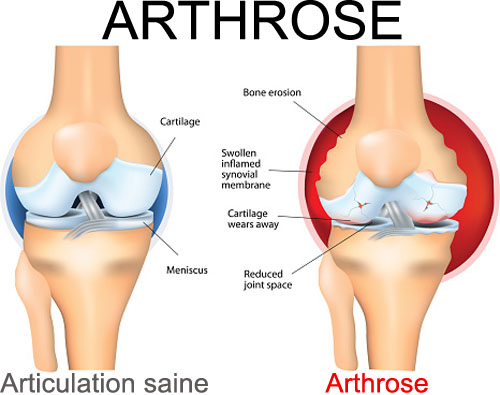Have a question? 06 70 73 89 02
🔞 Not for sale to under 18s
🎄 End of the year = Maximum discounts on ALL products 🎅
Have a question? 06 70 73 89 02

In its broadest sense, arthritis refers to inflammation of the joints, leading to the production of quinine and progressive destruction of the joints. In the narrower sense, it refers to more than a hundred different forms of inflammation affecting tendons, ligaments, nerves or other components of the musculoskeletal system[1].
Osteoarthritis is also a disease affecting the joints, but not through inflammation but through the breakdown of cartilage, characterized by mechanical pain (when the body is in motion) and can cause inflammatory problems[2].
They are therefore two diseases of the rheumatic family, both of which cause pain that can sometimes be disabling, but which differ biologically as well as in their causes and treatments[3].
Arthritis has an infectious, immune or metabolic cause. Joint deformity is called " hot" because it appears physically as redness or local overheating when the body is at rest.
Osteoarthritis is a mechanical pathology, often linked to age or extreme sporting activity, which causes cartilage to crumble, leaving the bones pressed against each other. The deformation of joints is referred to as " cold ", because it is not visible to the naked eye, and pain is felt when the body is in motion. The joints most prone to osteoarthritis are the shoulder, knee, hip, foot and facet joints of the spine[4].
 Rheumatoid Arthritis or RA is an inflammatory type of arthritis that usually affects knees. Rheumatoid arthritis of the knee the auto immune disease. The body's immune system mistakenly attacks healthy tissue[/caption].
Rheumatoid Arthritis or RA is an inflammatory type of arthritis that usually affects knees. Rheumatoid arthritis of the knee the auto immune disease. The body's immune system mistakenly attacks healthy tissue[/caption].
As these two diseases often cause more or less identical pain (even if the causes and onset times differ, see above), they are treated in parallel by the medical profession. Around a quarter of the French population suffers from joint problems, resulting in stiffness and disabling pain. Unfortunately, these diseases are not yet curable, which is why CBD is so important.
Numerous scientific studies have demonstrated cannabidiol's anti-inflammatory properties. It is widely used in the treatment of pain and the reduction of inflammation caused by these diseases. In fact, it interacts with two receptors in the brain, CB1 and CB2, which play a role in movement, coordination and the immune system[5]. Thus, on the one hand, cannabidiol acts as an analgesic in reducing the pain associated with these diseases, and on the other, as an anti-inflammatory reducing the impact of these diseases on the joints.
Several promising scientific studies (mainly on animals in 2011, 2014, 2016 and 2017)[6] have been conducted and are still ongoing, in an attempt to prove the impact of CBD use on the treatment of these diseases and/or the reduction of associated pain.
More recently, in 2019, a study conducted in the United States on humans proved the positive impact of CBD on arthritis for 54% of the subjects tested.[7]
Also in 2019, at the annual rheumatology meeting[9], a "U.S. Arthritis Power Research Registry" sample survey[8], reported that 93.7% of patients reported relief from osteoarthritis or arthritis pain with CBD .
People suffering from the rheumatic diseases arthritis and osteoarthritis can use CBD to complement traditional medicine and avoid the side effects of taking anti-inflammatory drugs.
CBD oil should be applied to painful joints by massage and/or ingestion, with a few drops placed under the tongue using a pipette(the perfect dosage will depend on the individual, body size, pain intensity, etc.). We recommend starting with small doses, i.e. 4 drops a day for an oil with a 10% concentration, and increasing the dosage if necessary).
Did this article help you? Check out our blog for lots of interesting info and keep up to date with CBD news!